This festival is also known as Jyothirbheemeshwara Vrata and Pathi Sanjeevini Vratha and it is mentioned in Skaanda Purana (Skanda Purana, one of the major eighteen Puranas, a Hindu religious text, is the largest Purana and is devoted mainly to the life and deed of Kartikeya (also called Skanda or Muruga), a son of Shiva and Parvati). The festival falls in the Hindu month of Ashada, July – August in the Gregorian calendar and celebrated in Karnataka. For all the festival dates click here.
The festival is all about women praying to Lord Shiva and his consort Parvathi for the well being of their husbands and brothers, generally all the male members of the family.
On this day, decorate the shrine with Rangoli and place a pedestal on which rice is spread. On the rice place two lamps with ghee / clarified butter. The lamps represent Lord Shiva and Parvathi. In between the lamps keep an idol of Ganapathi or Shiva / Ishwara or Mangala Gowri.
Tie a turmeric root to the right lamp. Smear turmeric paste to hasi dhara / thread and tie 9 knots and one flower. Prepare similar threads for every girl / woman who performs the pooja and keep it on the right side of the lamps on a betel leaf. Keep 9 betel leaves, 9 betel nuts along with coconut and fruits as offering.
Light the lamps before commencement of the pooja. The lamps and idol are worshipped with 9 string Gejjevastra / cotton strings, Ganda / Sandal Paste, leaves and flowers. Offer Bandara / stuffed steamed cakes, Kuchchida Kadabu, Coconut and Banana to god. Perform an aarathi and pray the lord for prosperity and good health.
The thread is tied on the right wrist of the girls and women by other women or the priest. Married women perform this vrata for nine years after marriage and in the ninth year a pair of lamps is given away to her brother or a Brahmin.
On this day there is a ritual with brothers known as “Bhandara Hodiyuvudhu / Breaking of stuffed steamed cakes”. For preparing the Bandara, mix wheat / rice flour with water to make a dough and roll out 2″ diameter round circles. Keep some soaked gram inside it along with some coins and close with another rolled dough and seal. Mold two spades using the dough. Steam them for 5 mts. This is usually not eaten.
Let the brothers sit on a mane / flat wooden slab inside the hochilu / bottom doorsill, apply tilak / vermilion mark on their foreheads and perform an aarathi.
Keep Bandara on either side of the hochilu / bottom doorsill on betel leaves, betel nut, coins. Apply turmeric powder and kumkum / vermilion powder to hochilu. The brothers are made to stand one at a time with legs on either side of the hochilu and he has to break the Bandara with his elbows and as he bends to break them the sisters should bang the brother’s back with their elbows. This is lot of fun with laughter and guffaws. The bandara is stuffed with soaked Bengal gram or with coins.
On Bheemana Amavasya deep fried or shallow fried food is not prepared on this day. Idli and Payasa along with Kuchchida Kadabu are prepared.
Legend associated with this festival –
The King and Queen of Saurashtra had a son who died a premature death. The King and Queen were sad, as they had dreamed of getting their son married in a grand manner. The King decides to get his son married even though he was dead and announced that a large amount of gold and cash would be given to the guardians of the girl. A poor Brahmin comes forward to marry his daughter to the corpse. The wedding is performed immediately. The day was Amavasya / no moon day dark and cloudy. As the celebration comes to an end, the corpse is taken to the banks of river Bhageerathi to perform the last rites. As the people were preparing the pyre, thunder and lightening strikes along with heavy rains. The people panicked and ran back to their homes leaving the corpse and the sobbing innocent girl next to the corpse.
The girl remembered that it was the day of Jyothirbheemeshwari vrata, which her mother made her perform without fail every year. She took bath in the river and molded two lamps and rolled out fiber of a plant to form the wick for the lamps. She poured water into the lamps and also remembered bandara and instead of the wheat / rice steamed cakes, she made mud balls representing bandara.
Lord Shiva and Parvathi were watching all her activities and were extremely pleased with her devotion and blessed her with all their energy. The girl lighted the lamps with water and performed the pooja using wild flowers and leaves. As she finished her pooja Lord Shiva and Parvathi appeared before her. Lord Shiva broke the mud balls / bandara and asked her to ask for a boon. She requested them to bring her husband back to life, which was granted. The people next day were happy and surprised to see the prince alive and they took the two back in a procession and they lived happily ever after.
Conclusion regarding the vrata and the legend is “wherever there is devotion there is god”.
For festival food list with recipes click here.
For festival snacks and drinks list with recipes click here.

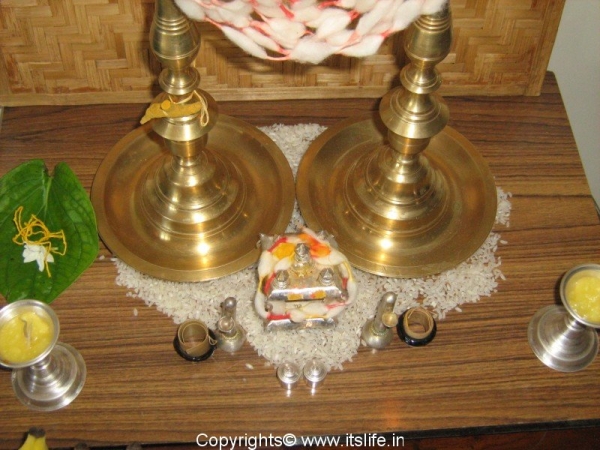
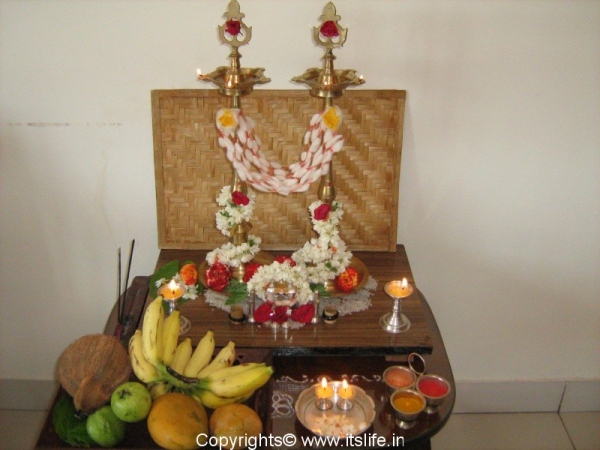



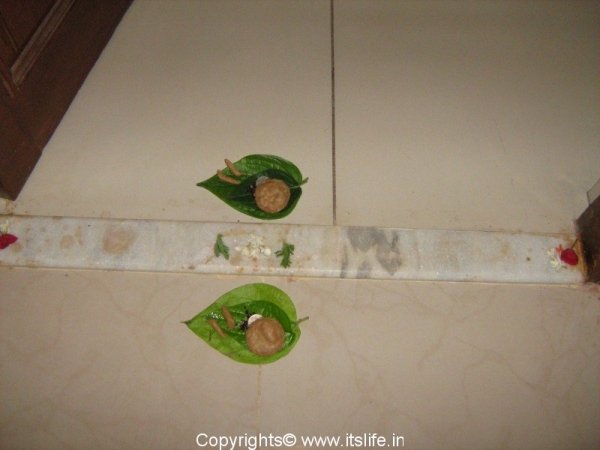
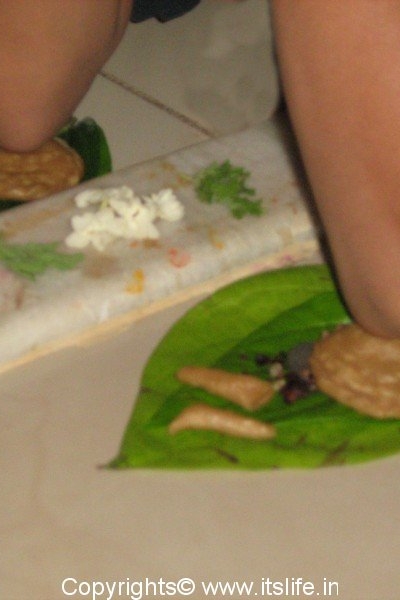

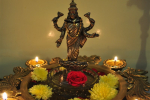
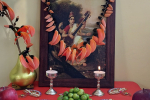
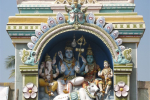
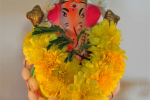
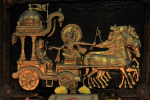
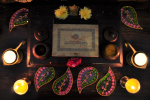
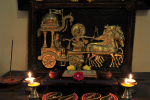

Hi!
Very nicely written. The pictures are really good. I had a request. Could you please post a simple puja procedure ( I have the puje patre .. tambge, panchapatre , etc) .I usually get confused with how many sips of water to take and how many to leave and also after which ritual .. dhoopa, deepa, arti, udi, mangalaarti .. It would be helpful if you could post the procedure and also a aarti song.
Thanks
Megha
Hi Megha,
Thanks for visiting and the comment. I am working on the simple daily Pooja ritual article. I will post asap.
Regards,
Shantha
Hi, Madam Shantha,
I am very much delighted to read and see the perfromance of JYOTHI BHEEMESHWARA VRATHA with pictures.
Really hats off to your work. It helps here to our people to perform the Pooja. You not only upheld our tradition and culture but where ever we are, can perform the Vrathas also without any problems.
Congrats to your work. Please keep it up.
Regards,
Venkatesh Chitradurga.
Cupertino, California – 95014, USA.
Hi Venkatesh,
Thanks for your lovely comments….it keeps me writing and researching more.
Cheers!
Shantha
Hi,
This is an awesome writeup about bhimana amavasya…i was thrilled to read the kannada terminologies..Thanks again….
well written-congrats-we celebrate plenty of festivals without going deep into -keep writing- k. sridhara
Thanks Samudyata, Sridhara…I am learning a lot as I am writing…
BEautiful.In the days where the sattelite channels and media are aping and promoting other cultures and making ignorant aaof the Indian rich culture this i fantastivc. These are to be told in schools also. It is well written.The specialaity of the festival ias well written. When we were young wait for this festival as on Chauthi day asiasters will give agift and and very good meals with NUCTHINA UNDE- adough is made using THOGARI bele- Turdal,(beaten), with salt,mirchi,etc and steam baked,along with KUCHINA KADABU.Speciality of Karnataka dish.
Thanks again for reminding..
Hi Balu,
I am elated reading your words of appreciation. Yum…Nuchchina Unde is my favorite too…find the recipe by clicking on the link below:
http://www.itslife.in/2008/08/nuchchina-unde
Visit again!
Shantha
Megha, I have posted two aarathi songs….will be posting more songs gradually….keep visiting.
Shantha,
Its something very commendable job that you are doing in posting the background information about a festival, how to celebrate them. It really helps a lot for those people who stay away from families due to work postings and dont have anyone to guide in case they forget. Very Good job and keep it up and am sure as you keep writing and researching for the sake of others it also enhances and deepens our own internal knowledge. As you educate others, we also in the process gain more knowledge and insight into the subject.
Yes Vishalakshi, the wealth of knowledge I am gaining by sharing is immense. Your words are my reward. Thank you.
Regards,
Shantha
Hey Shantha,
Usually we have bheemana amavasya celebrated with 2 wooden blocks which are smeared by gandha[sandal] and later on dots kept using chalk or sunna[lime].. How different is this celebration with that..?
And, could you please post articles on pooja procedures like when actually should we light deepa infront of God, after decorating with flowers on photos or before that.. and other basic known rituals for everyday pooja…
Thanks,
Nagashree.
To add to the above post, We are smarthas and I hope the daily pooja rituals are more or less the same as yours..
Regards..
Hi Nagashree,
The way you have described Bheemana Amavasya is new to me. Thank you.
I have never found much difference between Smartha and Madhwa brahmins. My mother is a smartha and my dad a madhwa.
One oil lamp is always lit in the pooja room. If you are asking about thuppada deepa then, I have observed that they are lit at the end of the pooja i.e. after the Mahamangalarathi.
Regards,
Shantha
dear Shantha
it is realy a wonderful information about bheemeshwara vrata
and
some peaple will prepare gowri and eshwara dolls on this occasion using mud
can you please inform me about how to prepare these dolls
Sorry Veena, I do not know how the dolls are made.
Beautiful post. Very well written. It made me nostalgic. I’ll be giving this link to the post I’m publishing today. Thanks a ton.
hey Shantha,
wanted to ask u celebrate all vrathas on ur own/thro cassette/some purohit?? which is best?
let me know… Thanks..
-Greeshma
Thanks Sushma.
Dear Greeshma, you have to take a call on whether you want a priest or a cassette. Both are suitable for me.
Thank you so much for posting this!
You are welcome Kum.
Shantha,
Can you post or mail me the story of JyothirBheemeshwar Vrata in Kannada if you have. Also tell me are the lamps to be lighted or now. Because someone told me that the lights that you keep as Shiva & Parvati are not to be lighted. We can keep additional lamps in front of the pooja lamps and light them. Is that correct??? Do Madhwas follow a different tradition of doing the pooja??? Pls help me clarify. I get confused at times.
Dear Vishalakshi,
We always light the lamp and do pooja. Shops in temples sell books on vratha, you can buy from there. I do not know whether Madhwas do it any other way.
Regards,
Shantha
i want to know the exact date of bheemana amavasya in the year 1966,1967 & 1968… please, can u….? and if possible mail it to my i.d.. i.e., raghu1509@gmail.com…
Sorry Raghavendra, I can in no way help you regarding this information.
Regards,
Shantha
Madam,
I realy hapy to read your writings about pathisanjeevani vratha to be observed on 30th instant this year. The photographs of bhandara are very good. This helps so many people who wants to perform the pooja.
thanking you,
murthy.
Hi Murthy Sir,
Thank you so much for your encouraging words. I would be so glad if this helps to perform the pooja.
Regards,
Shantha
Hello Shantha,
I am Glade by your information. Thank you so much.
I need a clarification on the pair of Deepa used.
Should these be a new one or can we perform pooja with the old Deepa only?
And on the 9th year, should we donate these lamps or a new lamps to brother/bramin?
Eager for your Replie
With Regards
Vijaya
Hi Dear Niru ma’am.
I m newly married and was looking for Bheemana Amavasya Vratha Katha n pooja vidhana audio , n found ur article as the result . Article is very nice n heplful for newly married ppl like us I wish to have audio r video of these vrathas
I wish to have audio r video of these vrathas
Thank u
Regards.
Good you found this article useful Santoshi.
Dear Shantha,

The only difference in breaking the ‘Bandhara’ that we do in my home is we keep the Bhandara on either edge of the hostilu rather on the floor. I was just curious as to the significance of either. Please advise if you know, I will ask my Mom too.
My son, (for getting goodies) and daughter(so that she gets to smack her brother!) eagerly look forward to this habba every year
Can’t wait for tomorrow to arrive.
~Nikhila.
Thanks,
Nikhila.
Hi Nikhila,
We never did the Bhandara breaking at home, as we are two sisters
I have written about how the others perform this custom. If that is way you have been doing, please continue, these small things hardly matters.
Enjoy the habba,
Shantha
Hi,
Nice pics and explanation. Thanks for the information:)
cheers
Swetha
You are welcome Swetha.
Hi Vijaya,
Oops! sorry missed out replying to your mail. Existing lamps at home can be used. In the 9th year buy a pair of new lamps and give dana.
Regards,
Shantha
This day is the death anniversary of my grandfather, who died a year ago aged 87.
Sad to hear Vishal. May his soul rest in peace.
which date bhimana amavasya in 1980
please reply me
Sorry Umesh, I don’t know the answer.
Hi Shantha,
This is really a nice thing to know about the festival, thought i am celebrating this festival from a very small age.
I know to sing the song of Bheemana Amavasya which my beloved grandmother thought me and i still sing it every year.
Hi Rohini,
Thanks for visiting.
I am happy to hear that you like to celebrate this festival.
Regards,
Shantha
Hi Shantha, This article is very nice and very well explained. I am not a Brahmin, and in my family no one had performed this pooja till now, neither my mom nor my mother-in-law. But I had heard from my friends about this pooja and started observing since my wedding. This is the 4th year I am performing this pooja. I was told to do pooja for lamps which were made of mud. I was doing pooja to lamps by decorating them and do paada pooja for my hubby. That was the end of the Bheemana Amavasya pooja. But after… Read more »
Hi Shwetha,
Good to know you are performing the pooja. It is not necessary that only Brahmin’s perform this pooja.
Thanks for visiting and sharing your thoughts.
Regards,
Shantha
Hi Shantha,
Iam in my 8th year of married life. Till now i have performed only once.. After reading this i want to start now. Can we start this any point of time? Means if i start now.. on 9th year can i donate the lamp to brahmin. Also i want to know that if i have to continue this forever till our lifetime or stop after 9 years. Please let me know.
Regards,
Shantha
Thank you very much.
Hi Shantha,
Sorry could’nt reply to you earlier as I was travelling on work.
Since your intention is devoting time to God, nothing should stop you from performing this pooja.
Disclaimer: This is my opinion and not written in any book. Only good can come out of devoting time to God
Regards,
Shantha
You are welcome Parvathi. Wish you happy festival season.
Should beemana amavasya be performed only for nine years? Or Can we continue after Nine years as well?